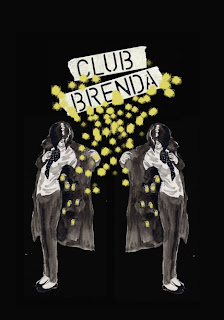
The launch will take place at Urbis, Manchester’s exhibition centre for contemporary culture in Cathedral Gardens, on Tuesday 1st December 2009 from 7:00pm – 10:00pm. The free event will include live bands from Jayne’s Switchflicker Records label, as well as a selection of DJs. There will also be the opportunity to purchase exclusive, limited edition artworks by Strange Trees contributing artists plus a free cocktail for the first guests through the doors so get yourselves to Manchester!

I caught up with Jayne Compton to chat about Club Brenda, Switchflicker Records and Strange Trees:
What inspired you to start Club Brenda?
Club Brenda began back in the 20th century – 1999 to be precise, after a drunken conversation between myself and the performance poet, Chloe Poems. We were on the night train back from Cream in Liverpool. We wanted to start a club that combined bands, poetry, performance art and a deliberately eclectic music policy. A place where Divine David and Chloe Poems could perform alongside lo fi bands and other performers.
How do you think Club Brenda has evolved over the past decade?
Its reputation has grown, it has launched some big Manchester bands like The Ting Tings yet it still feels underground. It’s minimally promoted and succeeds due to word-of-mouth from its misfit crowd. It is a genuinely uncompromising underground art-punk happening in the mould of Exploding Plastic Inevitable, Rabid at the Squat or Don Letts at The Roxy. The punters are as important as the acts. So is the feeling that everyone knows each other.
What is the concept behind Strange Trees and how did it come about?
Strange Trees is the visualization of Brenda – we had lots of artists and bands involved in Brenda who lurked in the shadows of the city, a book would be an additional format to showcase their work.
How did you decide what elements of Club Brenda’s history to include in Strange Trees?
We split the book into two parts, it opens with a series of classic narratives to form a dark urban fairytale, Instead of Jack and the Giant, we have Dirty Honky, turning vaudeville tricks for magic beans. Savage Wolf prowls through the ever-changing forest but isn’t quite the predator we expect, and the same goes for Holly Gore, who some like to call the witch… in the strange forest of Club Brenda, no one remains what they were…The second part is a series of commissioned photography, posters and artwork.
How did Club Brenda lead to the creation of Switchflicker Records?
When we started at the Star & Garter, People would just grab the mike and recite poetry. Anything could happen. Performers like Chloe Poems, Tracy Elizabeth, Fiona Bowker and Veba all contributed. This inspired myself and electronic artist, Mildmanjan to start Switchflicker records, we wanted to capture the best of these moments on limited seven inches. The first was Mildmanjan featuring Mark E Smith with Tracey Elizabeth and Veba on the flip.
Manchester has a great history of music and club nights; how much influence has the city and its history had on you and your projects?
Brenda was inspired by Hulme’s after-hours shebeen ‘party’ scene. When all the various clubs closed, the after party would continue in Hulme until the early hours of the morning. Brenda came from this same spirit - just people coming together to party in spite of their musical or cultural differences. The vibe was ‘lay down your weapons; have a good time’.
Club Brenda blends music, art, poetry and performance. How do you feel that these inform one another and how has this diversity added to the atmosphere of the club night?
It all adds to the atmosphere because no one is ever sure what to expect.
What do you hope for Club Brenda in the future?
To find more new spaces in Manchester to host it, to work with performers from further a field as well as local artists and to take Brenda’s club format to the theatre.
